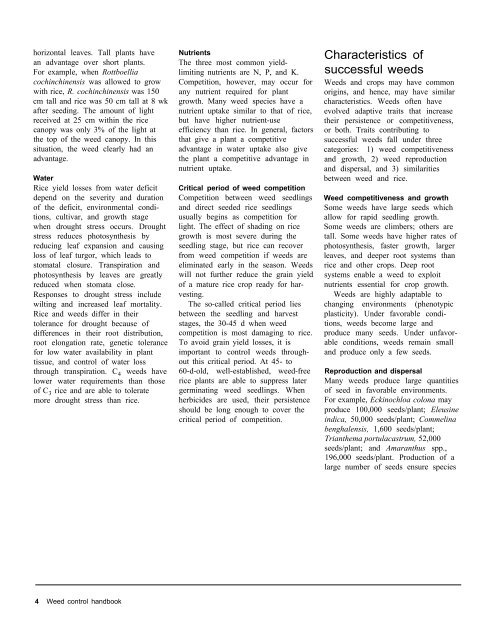A handbbok on Weed Control in Rice.pdf
A handbbok on Weed Control in Rice.pdf
A handbbok on Weed Control in Rice.pdf
You also want an ePaper? Increase the reach of your titles
YUMPU automatically turns print PDFs into web optimized ePapers that Google loves.
horiz<strong>on</strong>tal leaves. Tall plants have<br />
an advantage over short plants.<br />
For example, when Rottboellia<br />
coch<strong>in</strong>ch<strong>in</strong>ensis was allowed to grow<br />
with rice, R. coch<strong>in</strong>ch<strong>in</strong>ensis was 150<br />
cm tall and rice was 50 cm tall at 8 wk<br />
after seed<strong>in</strong>g. The amount of light<br />
received at 25 cm with<strong>in</strong> the rice<br />
canopy was <strong>on</strong>ly 3% of the light at<br />
the top of the weed canopy. In this<br />
situati<strong>on</strong>, the weed clearly had an<br />
advantage.<br />
Water<br />
<strong>Rice</strong> yield losses from water deficit<br />
depend <strong>on</strong> the severity and durati<strong>on</strong><br />
of the deficit, envir<strong>on</strong>mental c<strong>on</strong>di-<br />
ti<strong>on</strong>s, cultivar, and growth stage<br />
when drought stress occurs. Drought<br />
stress reduces photosynthesis by<br />
reduc<strong>in</strong>g leaf expansi<strong>on</strong> and caus<strong>in</strong>g<br />
loss of leaf turgor, which leads to<br />
stomatal closure. Transpirati<strong>on</strong> and<br />
photosynthesis by leaves are greatly<br />
reduced when stomata close.<br />
Resp<strong>on</strong>ses to drought stress <strong>in</strong>clude<br />
wilt<strong>in</strong>g and <strong>in</strong>creased leaf mortality.<br />
<strong>Rice</strong> and weeds differ <strong>in</strong> their<br />
tolerance for drought because of<br />
differences <strong>in</strong> their root distributi<strong>on</strong>,<br />
root el<strong>on</strong>gati<strong>on</strong> rate, genetic tolerance<br />
for low water availability <strong>in</strong> plant<br />
tissue, and c<strong>on</strong>trol of water loss<br />
through transpirati<strong>on</strong>. C 4 weeds have<br />
lower water requirements than those<br />
of C 3 rice and are able to tolerate<br />
more drought stress than rice.<br />
4 <strong>Weed</strong> c<strong>on</strong>trol handbook<br />
Nutrients<br />
The three most comm<strong>on</strong> yield-<br />
limit<strong>in</strong>g nutrients are N, P, and K.<br />
Competiti<strong>on</strong>, however, may occur for<br />
any nutrient required for plant<br />
growth. Many weed species have a<br />
nutrient uptake similar to that of rice,<br />
but have higher nutrient-use<br />
efficiency than rice. In general, factors<br />
that give a plant a competitive<br />
advantage <strong>in</strong> water uptake also give<br />
the plant a competitive advantage <strong>in</strong><br />
nutrient uptake.<br />
Critical period of weed competiti<strong>on</strong><br />
Competiti<strong>on</strong> between weed seedl<strong>in</strong>gs<br />
and direct seeded rice seedl<strong>in</strong>gs<br />
usually beg<strong>in</strong>s as competiti<strong>on</strong> for<br />
light. The effect of shad<strong>in</strong>g <strong>on</strong> rice<br />
growth is most severe dur<strong>in</strong>g the<br />
seedl<strong>in</strong>g stage, but rice can recover<br />
from weed competiti<strong>on</strong> if weeds are<br />
elim<strong>in</strong>ated early <strong>in</strong> the seas<strong>on</strong>. <strong>Weed</strong>s<br />
will not further reduce the gra<strong>in</strong> yield<br />
of a mature rice crop ready for har-<br />
vest<strong>in</strong>g.<br />
The so-called critical period lies<br />
between the seedl<strong>in</strong>g and harvest<br />
stages, the 30-45 d when weed<br />
competiti<strong>on</strong> is most damag<strong>in</strong>g to rice.<br />
To avoid gra<strong>in</strong> yield losses, it is<br />
important to c<strong>on</strong>troI weeds through-<br />
out this critical period. At 45- to<br />
60-d-old, well-established, weed-free<br />
rice plants are able to suppress later<br />
germ<strong>in</strong>at<strong>in</strong>g weed seedl<strong>in</strong>gs. When<br />
herbicides are used, their persistence<br />
should be l<strong>on</strong>g enough to cover the<br />
critical period of competiti<strong>on</strong>.<br />
Characteristics of<br />
successful weeds<br />
<strong>Weed</strong>s and crops may have comm<strong>on</strong><br />
orig<strong>in</strong>s, and hence, may have similar<br />
characteristics. <strong>Weed</strong>s often have<br />
evolved adaptive traits that <strong>in</strong>crease<br />
their persistence or competitiveness,<br />
or both. Traits c<strong>on</strong>tribut<strong>in</strong>g to<br />
successful weeds fall under three<br />
categories: 1) weed competitiveness<br />
and growth, 2) weed reproducti<strong>on</strong><br />
and dispersal, and 3) similarities<br />
between weed and rice.<br />
<strong>Weed</strong> competitiveness and growth<br />
Some weeds have large seeds which<br />
allow for rapid seedl<strong>in</strong>g growth.<br />
Some weeds are climbers; others are<br />
tall. Some weeds have higher rates of<br />
photosynthesis, faster growth, larger<br />
leaves, and deeper root systems than<br />
rice and other crops. Deep root<br />
systems enable a weed to exploit<br />
nutrients essential for crop growth.<br />
<strong>Weed</strong>s are highly adaptable to<br />
chang<strong>in</strong>g envir<strong>on</strong>ments (phenotypic<br />
plasticity). Under favorable c<strong>on</strong>di-<br />
ti<strong>on</strong>s, weeds become large and<br />
produce many seeds. Under unfavor-<br />
able c<strong>on</strong>diti<strong>on</strong>s, weeds rema<strong>in</strong> small<br />
and produce <strong>on</strong>ly a few seeds.<br />
Reproducti<strong>on</strong> and dispersal<br />
Many weeds produce large quantities<br />
of seed <strong>in</strong> favorable envir<strong>on</strong>ments.<br />
For example, Eck<strong>in</strong>ochloa col<strong>on</strong>a may<br />
produce 100,000 seeds/plant; Eleus<strong>in</strong>e<br />
<strong>in</strong>dica, 50,000 seeds/plant; Commel<strong>in</strong>a<br />
benghalensis, 1,600 seeds/plant;<br />
Trianthema portulacastrum, 52,000<br />
seeds/plant; and Amaranthus spp.,<br />
196,000 seeds/plant. Producti<strong>on</strong> of a<br />
large number of seeds ensure species











